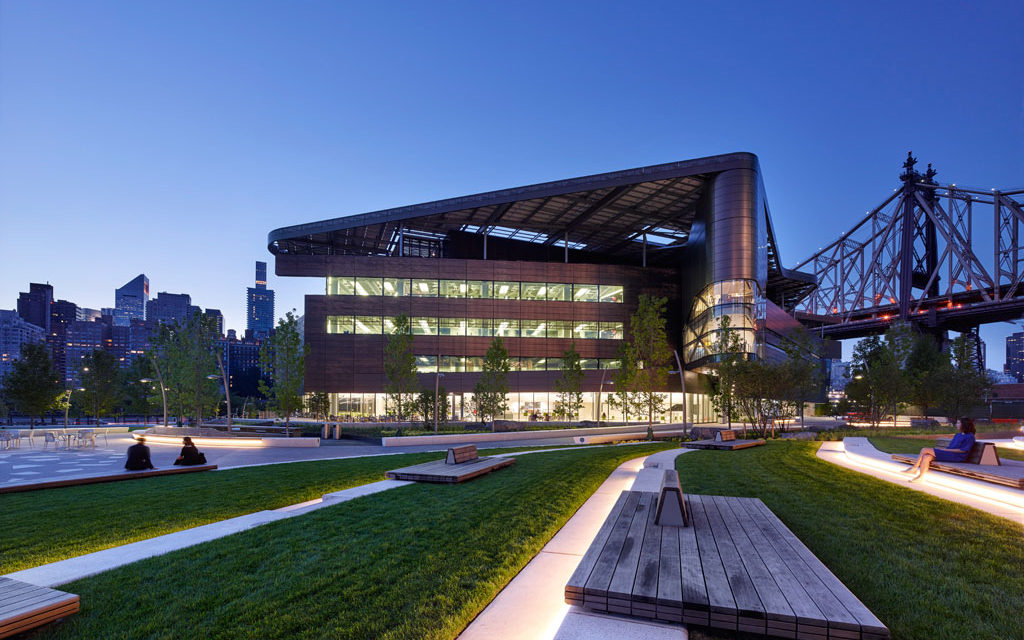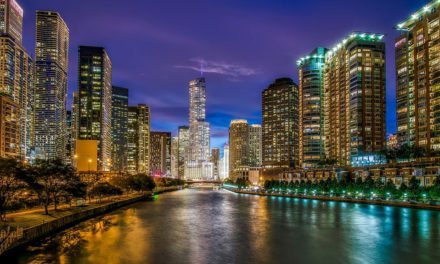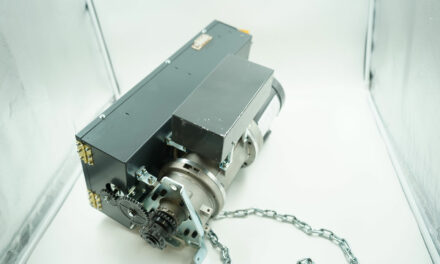Owner: Cornell University; Ithaca, New York
Architect: Morphosis Architects; New York
Metal Coatings: PPG DURANAR® VARI-COOL® Coatings
Coatings Applicator: Precoat Metals; St. Louis
Curtain Wall Fabricator: A. Zahner Company; Kansas City, Missouri
Architects specify rainscreen systems to fulfill two primary functions: the first is to keep moisture from entering a building; the second is to prevent heat from escaping. Thanks to a collaboration between Morphosis Architects, A. Zahner Company and PPG, the rainscreen system on The Bloomberg Center at Cornell Tech does more than serve those purposes – it also works as a color-shifting wall of art.
Set on New York City’s Roosevelt Island, The Bloomberg Center is the first academic building on the new Cornell Tech campus, an educational partnership of Cornell University and the Technion-Israel Institute of Technology. The 160,000-square-foot structure was designed by Morphosis to be the “intellectual nerve center” of the campus, with classrooms, instructional labs, conference rooms, a lecture hall, café and other shared spaces.

Photo credit: Matthew Carbone
The center also was planned with the ambitious goals of melding environmental sustainability with leading-edge design to achieve net-zero energy use and LEED® certification at the Platinum level.
The most visible expression of those objectives is the exterior layer of the rainscreen, an aluminum panel system that envelopes the four-story building to decrease its cooling load, while serving as a visual tether for its floating 40,000-square-foot solar canopy.
Featuring iradescent, color-shifting PPG DURANAR® VARI-COOL® coatings, the panels were designed by Morphosis with A. Zahner Company to create an artful façade that harmonizes with the local landscape.
Pixels and perforations
Zahner finished the panels with PPG’s iradescent coating; then, using its proprietary Louvered ZIRA™ system, perforated 337,500 two-inch circular tabs across the exterior surface of the rainscreen.
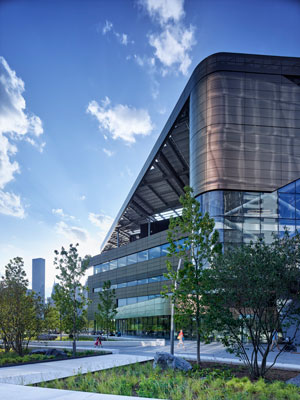
Photo credit: Matthew Carbone
Because the perforations are individually programmed to reflect a specific volume of light, they act like pixels that, when viewed from afar, produce a continuous image depicting Manhattan’s skyline on the west façade and the famous gorges of Ithaca, New York – near Cornell University’s main campus – on the east façade.
Formulated with an advanced 70-percent polyvinylidene fluoride (PVDF) resin, PPG Duranar VARI-Cool coating combines pearlescent pigments that change color according to ambient lighting conditions, with PPG’s proprietary ULTRA-COOL® infrared-reflective coatings technology, which deflects solar heat away from buildings to keep keep them cooler.
While The Bloomberg Center design team chose the coating in part to manage heat gain, the ability to shift color made it the product of choice for this project.
“We were interested in the concept of a dynamic building that changes under different light conditions during different seasons and from different perspectives,” said Ung-Joo Scott Lee, a principal with Morphosis and project leader for The Bloomberg Center. “We had never used the VARI-Cool product before, but we are always interested in exploring new materials and finishes.”
After reviewing a number of different colors, the design team selected Copper Brown Patina for its wide-ranging brown to greenish-blue hue. “The brown tone provides an industrial machine-finish quality that is similar to the Queensboro bridge nearby,” Lee explained. “The bluish-green hue is the color of the East River and the Cornell Tech landscape. Together they, very literally, marry the building to its new Roosevelt Island campus in New York City.”
The digital patterning of the perforations was created by running the rainscreen panels through a repurposed welding robot. Students from Cornell Tech and the Massachusetts Institute of Technology (MIT) collaborated with Zahner to develop the algorithm that controlled the device, which made them major contributors to the façade design.
Lee said the students’ involvement was deliberate and strategic. “We had been working with Zahner for several years because they share our design interests and curiosity, with meticulous care for detail and constructability,” he explained. “The students were engaged because they are talented, but also to emphasize the type of connections that Cornell Tech will foster between academia and the tech industries.”
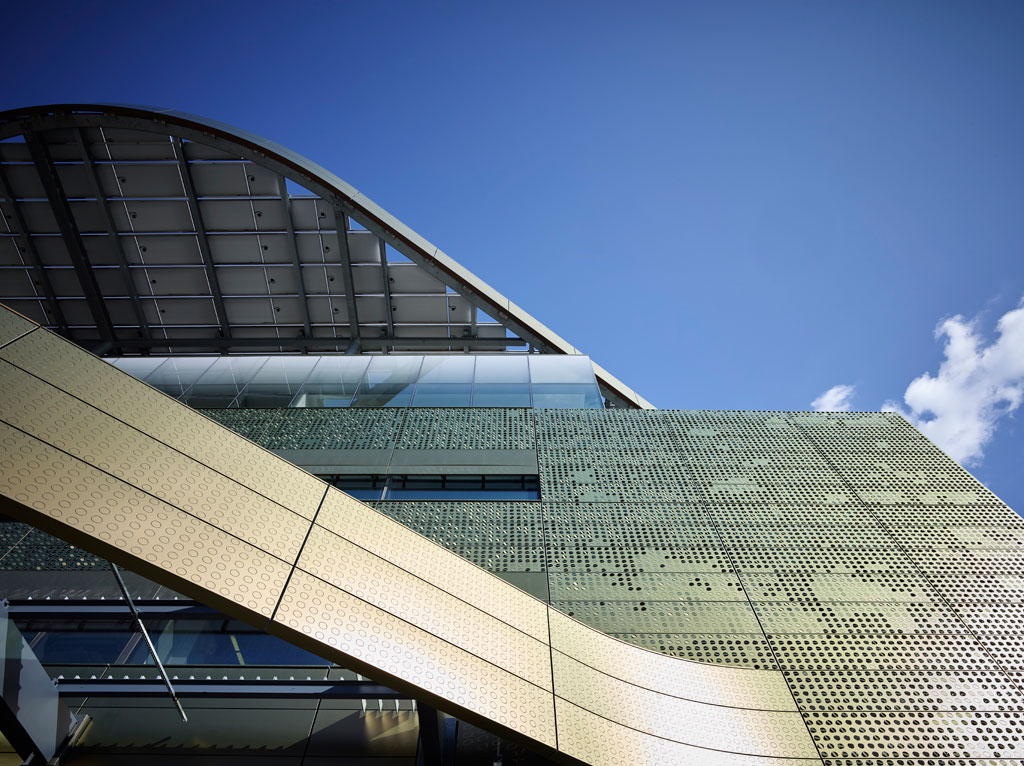
Photo credit: Matthew Carbone
Scott Moffatt, PPG market manager, architectural coil and extrusion coatings, worked with Zahner to make sure the coating would meet the long-term performance challenges associated with the building’s riverside setting.
“Zahner contacted us because they planned to laser-cut the perforations into the panels after the coating had been applied, and they were concerned about disrupting the paint finish,” he explained. “They sent us a few sample panels and we ran the corrosion tests. The results were positive, so everything was approved.”
The façade also incorporates cut-aways to accommodate wide bands of high-performance glass, enabling it to achieve the recommended 60:40 wall-to-window ratio for balancing opacity, outdoor views and natural light transmittance.
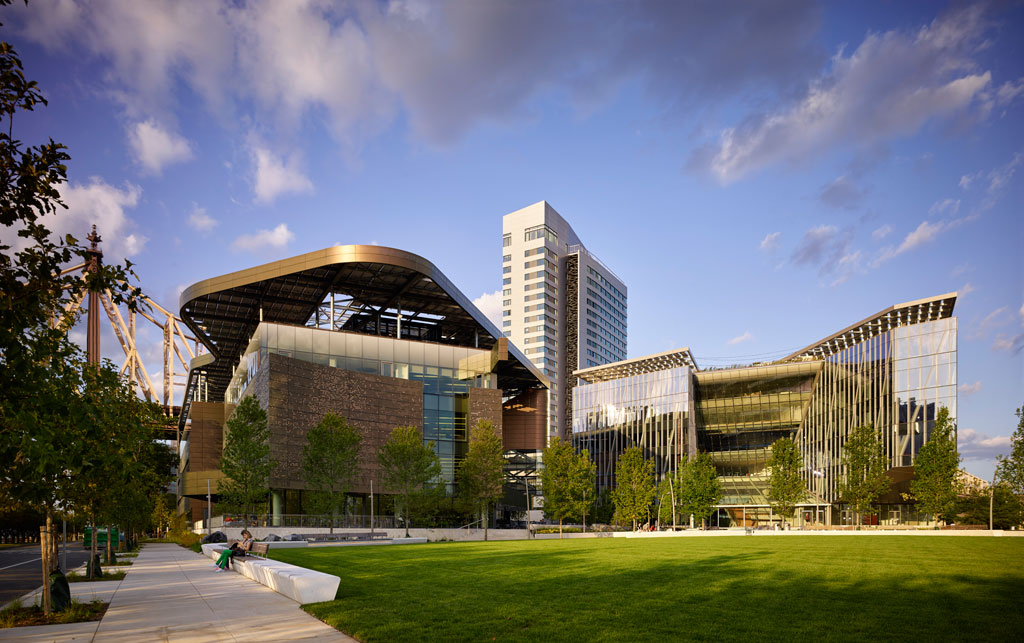
Photo credit: Matthew Carbone
Designed to be one of the country’s largest net-zero-energy academic buildings, The Bloomberg Center features smart building technologies; geothermal wells with ground-source heat pumps for heating and cooling; a 40,000-gallon rainwater harvesting system; and a green roof planted with native species.
These strategies, together with the photovoltaic-paneled canopy, are expected to help the building generate as much energy as it consumes, a difficult achievement for a technology-intensive academic center that is in constant use.
To learn more about PPG Duranar VARI-Cool coating and how it can add beauty and energy-efficiency to a high-performance building envelope, visit www.ppgmetalcoatings.com or call 1-800-258-6398.

